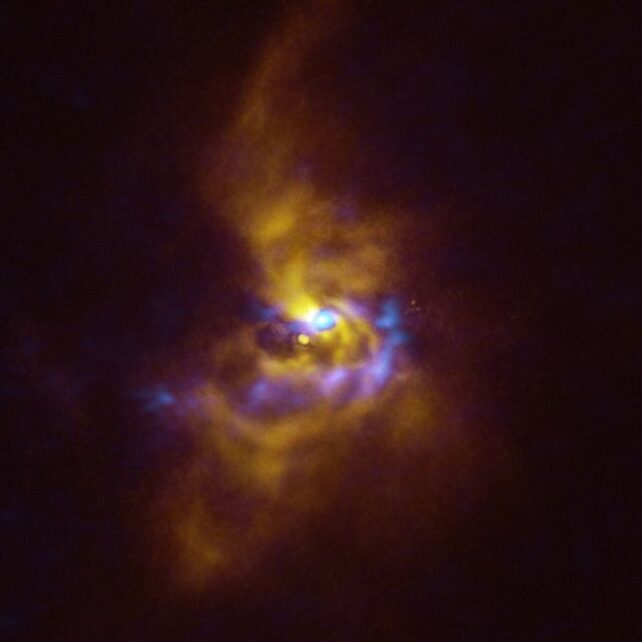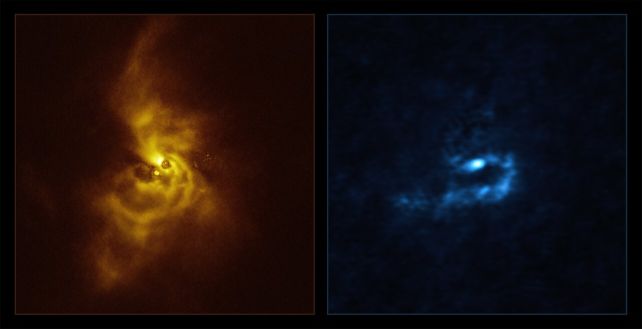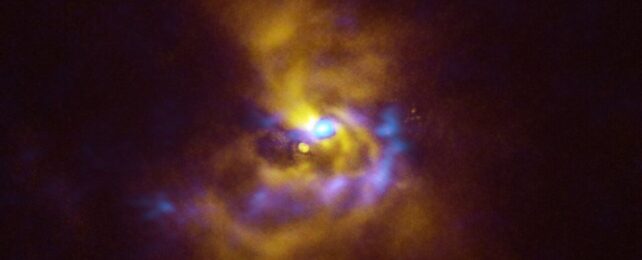New observations of the roiling cloud of dust around a baby star have revealed what looks like the early stages in the gestation of giant planets.
By using the Very Large Telescope and the Atacama Large Millimeter/submillimeter Array, astronomers have identified clumps in the thick material around a star named V960 Mon that could gravitationally collapse to form the seeds of planets like Jupiter.
It's a discovery that could help us better understand the formation of these huge worlds, a process shrouded in dust and mystery.
"This discovery is truly captivating as it marks the very first detection of clumps around a young star that have the potential to give rise to giant planets," says astronomer Alice Zurlo of the Universidad Diego Portales in Chile.
According to models, gas giant planets have two possible formation routes. You start with a baby star, surrounded by swirling material leftover from the star's formation. It's from these leftovers that planets are born.

The first way is core accretion, the same way rocky planets like Earth and Mars form. This is the bottom-up model, where clumps of material stick together and accumulate to grow into a planet. The other way is top-down, which is how stars form: a denser clump in a dense cloud collapses under gravity to form the baby planet. This is the gravitational instability model.
Both scenarios are plausible, so astronomers have looked for signs in the material around baby stars that offer clues about the early stages. And recent technological and analytical advances have made discovering slight variations in the distant dusty material a lot more possible than it used to be.
V960 Mon is a young star, an estimated 7,120 light-years away in the constellation of Monoceros, the Unicorn. It's so young that it has been caught flaring brightly – an event scientists interpret as an accretion event, material from the cloud falling onto the still-growing star.

Observations of the star taken using the VLT's optical and near-infrared SPHERE instrument two years after a 2014 outburst that saw the star flare to 20 times its previous brightness revealed strange structures, like the spiral arms of galaxies, in the material around V960 Mon. This sent a team of scientists led by astronomer Philipp Weber of the University of Santiago, Chile scurrying to see what they could find in radio data from ALMA.
The ALMA data revealed that the disk of material around V960 Mon is undergoing a process called fragmentation, which is a crucial part of the gravitational instability model. The disk fragments into clumps that collapse into planet seeds. And indeed, the team found clumps in the spiral arms around V960 Mon, each around several times the mass of Earth.
"No one had ever seen a real observation of gravitational instability happening at planetary scales – until now," Weber says.
Future work from current and upcoming telescopes will seek to study other such outbursting young stars in the hopes of uncovering further evidence of disk fragmentation and gravitational instability in planet formation.
"For over a decade, we've been hunting for these clumps with ALMA, as theories of planet formation predict their presence for the creation of large planets," says astronomer Sebastián Pérez of the University of Santiago, Chile.
"Our discovery may draw direct connections between the formation of stars and planets."
The research has been published in The Astrophysical Journal Letters.
